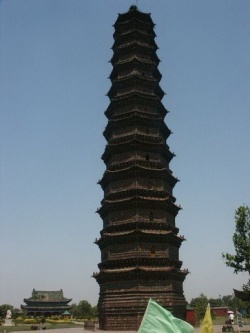Youguo Temple Iron Pagoda in Kaifeng of Henan Province
The Pagoda is also known as the Iron Pagoda in Kaifeng. Actually it is not made of iron, but of red, brown, blue and green glazed bricks. As the main hue is reddish brown, the Pagoda looks like iron from afar and has thus been called the Iron Pagoda for hundreds of years.
The Pagoda is located in the northeastern corner of Kaifeng. The predecessor of the Iron Pagoda was a huge octagonal, thirteen-storeyed wooden Pagoda called Lingwei. It was once very famous, but for a very short Time. In 1044 during the Northern Song Dynasty the wooden Pagoda was struck by lightning and burnt down. Five years after the wooden Pagoda was burnt down, the emperor of the Northern Song Dynasty ordered another one built on the same site. This Time it was built of Fire-resistant glazed bricks that remain today. It has been almost one thousand years since the Pagoda was rebuilt, but it remains firm despite fierce winds, torrential rains and earthquakes. In 1841 the Yellow River overflowed and the city of Kaifeng was flooded. The thousand-year- old temple collapsed in the flood, but the towering Pagoda survived and stood firm.
The thirteen-storey brick structure, modeled after wooden counterparts, is 54.66 meters high. The glazed bricks are lined with ordinary bricks. The doors, windows, pillars, brackets, bracket supports, pent roofs and balconies on the Pagoda's exterior are all modeled after wooden ones and pieced together from twenty-eight standard brick components. The outer walls, comer pillars, doors, windows and bracket supports are all composed of glazed bricks of various colors. Carved on these component parts are more than fifty ornamental designs, including images of Buddha, Bodhisattvas, flying apsarases, heavenly kings, celestial guards, lions, unicorns, musicians, peony and Lotus Flowers and figurines, making the Pagoda the oldest and largest artifact of glazed bricks and tiles in China.
Under the main Body is a high stone Sumeru pedestal that has been buried by mud because of frequent flooding by the overflowing Yellow River. The present Pagoda has doors on four sides, but people can approach the Pagoda only by the steps on the north side.
